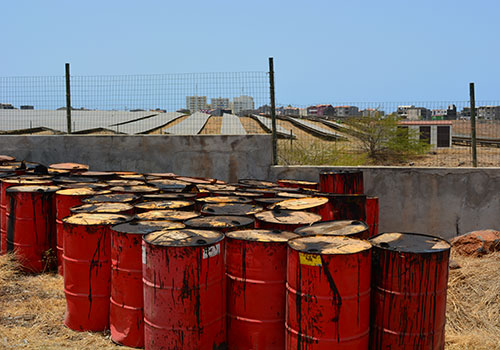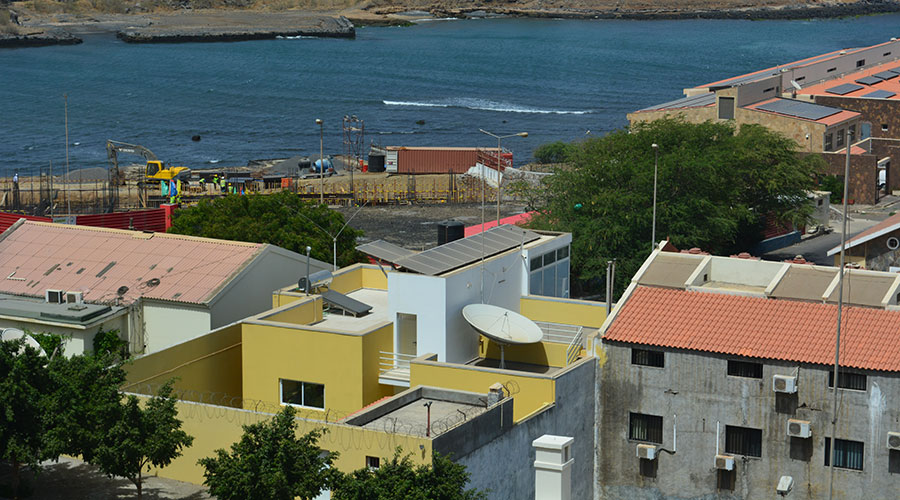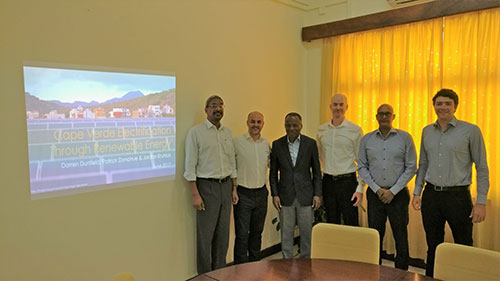A capstone project may transform electricity generation in the African nation
 Three 2017 Alternative Energy Technology (AET) grads have found a way to move a small African nation closer to the exclusive list of countries – including Paraguay, Albania and Iceland – running entirely on renewable energy.
Three 2017 Alternative Energy Technology (AET) grads have found a way to move a small African nation closer to the exclusive list of countries – including Paraguay, Albania and Iceland – running entirely on renewable energy.
In their final term, AET students are paired with an industry partner to complete a capstone project that solves a real-world problem. In winter 2017, Darren Dunfield, Patrick Donohue and Jordan Kruhlak partnered with E+, a green energy startup with ambitions to work with Cape Verde, a country of 550,000 people located 570 kilometres off the northwest coast of Africa.
The goal: find a practical way to overhaul the country’s inefficient and unsustainable electric power infrastructure.
“The company we were working with wanted to take the island nation of Cape Verde from a heavy dependence on fossil fuels and convert as much of the electrical grid as possible to renewable energy,” says Kruhlak.
The team knew that, if successful, a solution based on renewable resources would not only provide Cape Verde with cheaper and cleaner energy but likely improve citizens’ quality of life.
Great need for electricity
In Cape Verde, the need for cheaper, cleaner energy is very real. Because the country has no domestic natural gas, oil or coal, it imports fossil fuels such as high-polluting bunker fuel and diesel for much of its energy generation.
 These sources of power are not inexpensive. In 2016, electricity on Cape Verde cost $0.28 to $0.40 per kilowatt hour – or as much as 10 times higher than electricity in Alberta today at the time (not including distribution and transmission charges). These costs also contribute to inflated food prices.
These sources of power are not inexpensive. In 2016, electricity on Cape Verde cost $0.28 to $0.40 per kilowatt hour – or as much as 10 times higher than electricity in Alberta today at the time (not including distribution and transmission charges). These costs also contribute to inflated food prices.
To make matters worse, Cape Verde requires far more electricity than a country of its size due the need for water desalination. There is virtually no natural freshwater on the islands and Cape Verde sees more than 360 days of sunshine a year with very little precipitation.
How do residents of a developing island nation pay for such costly electricity?
With a per capita GDP of just under $3,000 USD (Canada’s is more than $42,000), many Cape Verdeans can’t. Instead, they’re forced to steal it. It’s estimated that between 30% to 40% of all power generated in Cape Verde is stolen. Finding a new power solution could not only make power affordable, but make its generation profitable.
A trip to Cape Verde
 Though the islands lack conventional resources, the AET team knew that sunny climate and steady ocean winds make Cape Verde an excellent candidate for solar and wind power.
Though the islands lack conventional resources, the AET team knew that sunny climate and steady ocean winds make Cape Verde an excellent candidate for solar and wind power.
By focusing on wind and solar power generation, and incorporating a system of storage (see sidebar below), the team drafted a plan to increase countrywide power from renewable technologies from 18% in 2018 to 67% by project completion, the timing of which depends on funding.
On the country’s two largest islands by population, Santiago and Sao Vicente, the team expects they could hit 83% and 84%, respectively, using renewable sources. Consumer electricity costs would drop steadily, and in eight years residents could expect a price of roughly $0.11 per kilowatt hour. All this for an investment of roughly $220 million USD.
 In June 2017, Kruhlak and Dunfield flew to Cape Verde to present their recommendations to the Prime Minister, José Ulisses de Pina Correia e Silva.
In June 2017, Kruhlak and Dunfield flew to Cape Verde to present their recommendations to the Prime Minister, José Ulisses de Pina Correia e Silva.
“It was a really cool experience,” Kruhlak says.
“We went into their parliament building and got set up for our presentation. Eventually the Prime Minister walked in and said he had five to 10 minutes for us, but we had planned for a 20-minute presentation plus time for questions. So we went through it as quickly as possible, and after 15 minutes he said he would push his next meeting. He was very interested in what we had to say.”
Capstone of the year
On April 6, Alternative Energy Technology grads (Class of '17) Darren Dunfield, Patrick Donohue and Jordan Kruhlak earned a Capstone Project of the Year award from Association of Science and Engineering Technology Professionals of Alberta (ASET). The team won for its study to virtually eliminate the use of fossil fuels for electricity generation in Cape Verde.
E+ founder Yamandou Alexander describes the result of the students’ work as an “almost mature” prefeasibility study. “There is some work remaining to be done but, for students, they reached a level beyond expectations. They were able to demonstrate the potential of bringing Cape Verde to 100% renewable [energy].”
Alexander will put their study to use in negotiating with the government of Cape Verde in the hopes that work will be able to proceed.
AET program chair Dr. Jim Sandercock sees the calibre of the project as a sign of things to come, particularly with emerging needs in developing parts of the world.
“Across the world right now, we’re seeing that the way we’re generating energy – electricity, heat, cooling, transportation – is undergoing significant changes. We’re kind of in this industrial revolution era.”
Kruhlak says it’s been thrilling for the team to apply skills they’ve learned in the classroom and contribute to this transformational change.
“It’s been an amazing experience,” he says. “We’re so fortunate to have had this opportunity.”
Storing electicity at Cape Verde
By using renewable resources, Cape Verde could produce more energy than it requires. Unlike Alberta, however, which can sell its excess power to neighbouring provinces and states, the African nation’s geographic isolation (even from one of its islands to the next) prevents this.
“We focused on solar and wind,” says Dunfield. “But it was important to augment those systems with storage.”
The team chose pumped hydro energy storage. In times of excess generation (lots of sun and/or wind), water is pumped to an upper reservoir. In times of low generation, the water is released through a turbine to produce electricity.
“We also chose pumped hydro to increase their freshwater storage capacity,” says Dunfield, noting that the system would catch and use rainwater. This water would not only reduce the country’s reliance on desalination, but could also provide agricultural irrigation.